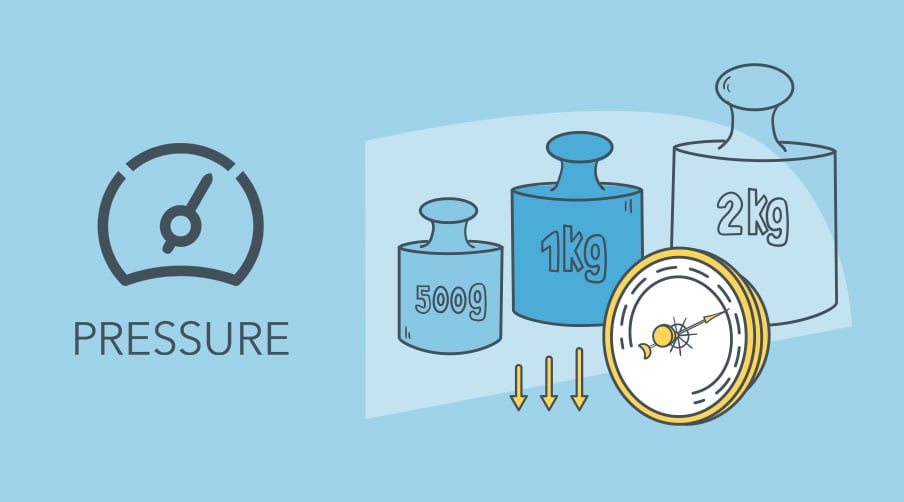
Learn why measuring and controlling air pressure is important for health, wellbeing and energy efficiency.
Air pressure is a part of our everyday lives, yet little is certain about its effects on people at work. However, there is a body of scientific evidence which suggests that it can impact health and wellbeing.
This considered, businesses and organisations should take steps to ensure optimal air pressure in their buildings. This article guides you through some of the reasons why it’s important to do this, including implications for energy consumption.
Air pressure, also known as atmospheric or barometric pressure, is the force applied by air molecules[1] as they press down on the earth and all other surfaces. This includes people, objects, and walls.
Many of us don’t think too much about air pressure, but it’s essential to the way humans live. When we breathe, we expand our lungs and reduce our internal pressure. Because gases tend to flow from high to low pressure places, air is then able to flow into our lungs. Air pressure also has many commercial uses such as tires, syringes, and airplanes.
There are various environmental factors which can affect air pressure in any given area, but some of the main ones are temperature and the density of the air molecules.[2] Hot air molecules cause air pressure to increase because they exert more force, whereas cold air molecules are more dense so they don’t move as much.[3]
Usually, air pressure is measured in hectopascals (hPa), but millibars are also commonly used.[4]
It’s important to measure air pressure in buildings and offices because an imbalance can cause discomfort to workers inside. When the air pressure outside a building is higher than it is inside, a phenomenon called negative pressure happens.[5] In the summer months, warm air from outside will make its way inside–this may increase your cooling costs. In the winter months, cool air will instead be drawn in which can equally overexert your HVAC system and drive your heating costs up.
When the air pressure inside a building is higher than it is outside, the opposite phenomenon happens. Positive air pressure is considered to be ideal during the summer, because humid air is kept outside. However, during the winter, the more humid indoor air can be drawn toward the edges of the building (like the walls), where it may condense into moisture. This can cause mold and other related problems to appear.
There is evidence that suggests that air pressure can have an impact on health and wellbeing, but scientists have not necessarily agreed on how. For example, it is theorized that changes in air pressure may trigger arthritis and joint pain–but because air pressure is related to other weather factors (like temperature and humidity), it is difficult to pinpoint the true culprit.[6]
Other than joint pain, air pressure can also cause headaches[7] and more frequent migraines.[8] The reason for this may be related to our sinuses, which are hollow cavities filled with air. When there is a change in atmospheric pressure, there can also be an imbalance in our sinus pressure. This can cause inflammation and pain.[9] Another possible theory is the fact that air pressure can influence the way our blood vessels widen and narrow, which can trigger migraines.[10]
In a study conducted in the United States, migraines have been linked to decreased productivity in the workplace.[11] In order to reduce employee sick leave, business and office managers should take steps to maintain good indoor air quality.
It’s important to keep in mind that air pressure and differential pressure are not the same thing, even though it can be difficult to talk about one term without mentioning the other. In short, air pressure refers to the force of the air molecules. Differential pressure, on the other hand, is about the difference in air pressure between two areas. As mentioned earlier, indoor air pressure can often be very different to the air pressure outside. When you’re moving around a large building (like a skyscraper, for example), you might even feel differences in air pressure depending on how high up you are.
[1] https://www.dictionary.com/browse/air-pressure
[2] https://scied.ucar.edu/learning-zone/how-weather-works/highs-and-lows-air-pressure
[3] https://www.britannica.com/science/climate-meteorology/Atmospheric-pressure-and-wind#ref53284
[4] https://www.metoffice.gov.uk/weather/learn-about/weather/how-weather-works/high-and-low-pressure
[5] https://www.ecohome.net/guides/2221/air-sealing-for-air-tightness-of-homes-relies-on-balancing-air-pressure-in-a-house/
[6] https://www.health.harvard.edu/blog/can-the-weather-really-worsen-arthritis-pain-201511208661
[7] https://www.nhs.uk/conditions/headaches/10-headache-triggers/
[8] https://www.ncbi.nlm.nih.gov/pmc/articles/PMC4684554/
[9] https://www.dur.ac.uk/news/newsitem/?itemno=44499